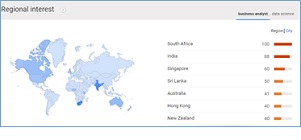Business Analytics: The “sexiest job” is also stimulating
By Sray Agarwal
After Harvard Business Review tagged Data Scientist as the Sexiest job of 21st century, there has been a huge surge in both demand of data scientist (a.k.a business analyst) and supply of data scientist. However, there still continues to be a mismatch in the demand and supply conditions. According to the McKinsey Global Institute “By 2018, the United States alone could face a shortage of 140,000 to 190,000 people with deep analytical skills as well as 1.5 million managers and analysts with the know-how to use the analysis of big data to make effective decisions”, and this further adds glamour to the sexiest role as it goes on to be one of the most sought-after career across the world.
A data scientist must be equipped with the knowledge of statistics and programming along with a sharp business acumen. This is a career that witnesses an amalgamation of art and science in a fascinating manner. Therefore, it is mandatory for a data scientist to possess logical thinking capabilities with a strong hold on the fundamental techniques along with an out of the box thinking to innovate and provide creative solutions for the business problems.
Today, almost all companies across industries and verticals are adopting analytics as one of the important business functions. Be it BFSI where credit risk modelling, risk analytics, churn analytics are a typical data science practices or e-commerce/retail/CPG where consumer analytics, marketing analytics, supply chain analytics, pricing analytics, social media and web analytics dominates or be it telecommunication where customer profiling, new product analytics, product analytics are being tried more often to name a few.
Career opportunities for an analyst is just not confined to aforementioned industries. There is a huge demand in pure-play analytics firms and consultancies too.
Typically a business analyst or a data scientist comes with a prior work experience before plunging full-fledged into this career. But given today’s market scenario, even a fresher is considered as a prospective business analyst. With a specialised course, armed with a capstone project and an exposure to internship, even a fresher can be recruited at an entry level. Typically an entry level analytics aspirant would be involved in more of database management, data modelling, data cleaning and basic modelling. Although, just with a few years of experience, the growth curve becomes very steep and the same person can grow to be in the leadership positions or strategic decision-making positions.
In response to this demand, several institutes and universities have started programs especially designed for data science aiming towards different target audience based on their prior qualifications and work experience. Training institutes conduct skill intensive courses that focus on concepts and their practical application with an interface of the job relevant tools such as R or SAS. Moreover, these institutes are extremely particular about the connect with the industry experts and provide ample exposure to the participants to the extent that the courses are conducted by the professionals who possess the relevant subject expertise from diverse verticals and industries. This continues to add the element of dynamism to the learning.
A quick glance at glassdoor.com (figure 1) would reflect the kind of compensation being offered at entry level to analyst while a google trend would be enough to (Figure 2 and Figure 3) understand the kind of interest in this career.
For starters, one can enroll in an institute that covers almost all dimensions of analytics viz. data management, data modelling, data visualisation, basic statistics, predictive modelling, forecasting and machine learning along with a focus on business interpratation and business case studies. Along with these topics, there should be enough coverage on any one (or more) analytics tools such as R or SAS or Python.
Today, a fresher doesn’t need to choose specific domain for specialisation. it is imperative to concentrate on learning anlytics practices across domains, and once in the industry for few years, a choice can be opted for; to either grow as a data scientist and move up the ladder into leadership roles handling varied business problems or get into specialised field like text analytics, consumer analytics, risk analytics, pharma analytics and so on and so forth.
As you sow, so shall you reap is commonly known saying and so is the case with budding industry too. Since the career is quite lucrative and is in demand, the kind of hard-work needed for an entry level foray into this career is equally challenging and demands effort in undertsanding the concepts and to constantly keep yourself updated with the recent happenings in the industry. As told earlier, a data scientist not only needs to have a strong foundation of the techniques he will be using but also needs to adopt continous learning habit. Industry is evolving and newer solution being developed in the blink of an eye. Being abreast with latest happening and trends in the market will ensure you are sharp and ready to revolutionise the industry.
About the Author:
Sray Agarwal is Chief Manager-Business Analytics at TimesPro (Times Centre for Learning Ltd.). He is Indian School of Business (ISB) alumnus.
This account contains a repository of informative articles by external authors with domain expertise in various aspects of guiding students on how to go about pursuing their undergraduate and postgraduate studies in... Read Full Bio





